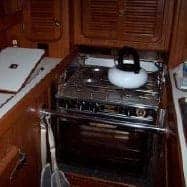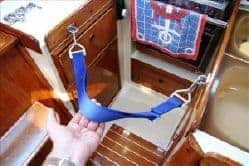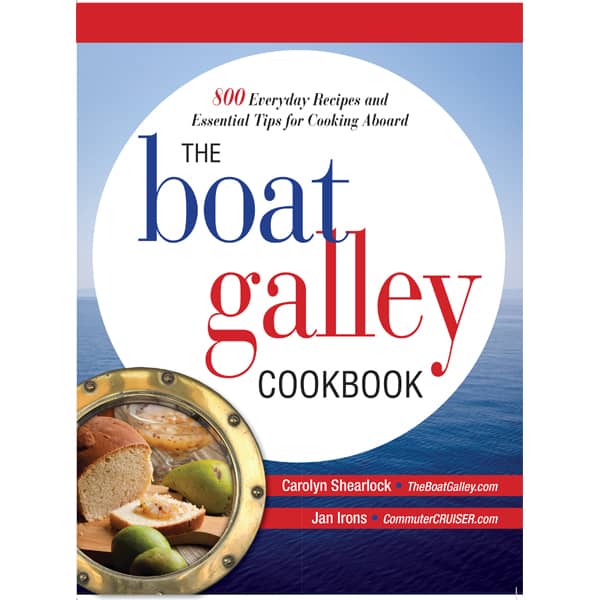 When I first wrote about galley design and things to look for, one of my points was a design where the cook couldn’t get tossed across the boat in rough conditions.
When I first wrote about galley design and things to look for, one of my points was a design where the cook couldn’t get tossed across the boat in rough conditions.
Several people have written me and made comments about how a galley strap can solve that problem in almost any design. I have mixed feelings on galley straps . . .
Both the friend’s boat that I was on for my first offshore passage and Que Tal had a West Marine galley strap. The photo isn’t great, but these were basically about 3 feet long with a snap on either end. Most of the length was a pad about 6 inches wide and the length could be adjusted. Both boats had pad eyes on either side of the stove so that you could clip yourself directly in front of the stove (this photo, from a friend, shows just clipping the strap to the grab rail).
After using one once, I quickly concluded that this was a horribly dangerous concept. Who wants to be held in place right in front of fire and pans of hot food? If a pan spilled, I couldn’t jump out of the way — I was a sitting duck for burns!
There were other problems with this concept:
- It didn’t help me in any other place in the galley — getting into lockers, standing at the counter or using the sink was still an invitation to be thrown across the boat if I couldn’t wedge myself in.
- It took both hands to clip myself in — it’s hard enough to cook with just one hand while holding on with the other, but to have to use both hands for yourself made it even tougher when you needed to get something from another area of the galley.
Obviously, no one else particularly liked this design as they are no longer sold (I’ve found some other articles also talking about how being held in front of the stove is a hazard). And that’s where this article was going to end — basically that I didn’t like the idea of a galley strap and thought that it was much better to simply have a galley design where you could wedge yourself in.
But then I started researching this article and found some other galley strap ideas that I do like. Inasmuch as I could wedge myself into the galley on Que Tal, I doubt that I’d set either type up. But if you have a more open galley design, you might want to think about something similar:
 With a U-shaped galley, you can place a strap across the opening. While it won’t hold you in one place, it will keep you from being thrown 6 feet or more and you can move around the galley and get out of the way of spills if need be. I’d tighten it up more than shown in the photo, though, so that it would hit me more at the waist. I’m afraid that with it at hip level, I could fall over the top of it. (NOTE: this photo is from a boat for sale.)
With a U-shaped galley, you can place a strap across the opening. While it won’t hold you in one place, it will keep you from being thrown 6 feet or more and you can move around the galley and get out of the way of spills if need be. I’d tighten it up more than shown in the photo, though, so that it would hit me more at the waist. I’m afraid that with it at hip level, I could fall over the top of it. (NOTE: this photo is from a boat for sale.)
- For an L-shaped galley, I really like this idea on the Catalina 34 Project pages. It’s very similar to the one above, except that it goes diagonally from one corner to the other and allows the cook to move within the galley area. The poster, Dan Harrington, makes a point of noting how he deliberately kept the strap high — hitting the small of the cook’s back — and I think that’s a good way to avoid the “falling over the strap” problem.
- For a long galley, I think you could create a strap running the full length of it if you keep it high enough and taut enough. Those long galleys have great counter space, but often have no places to brace yourself. A long strap would allow the cook to move sideways to avoid a hot spill — maybe not the most instinctive move, but better than not being able to move at all. Such an arrangement would also allow the cook to be restrained when getting into the lockers, at the counter (although I like to sit to chop or slice if it’s not smooth) and at the sink.
I also found a couple of posts about designing and installing stainless bars as a gate to “close off” the galley area on a Saga 43, but no photos. That could be another option for a really wide-open galley.
My conclusion: I still think that the galley straps that hold a cook right in front of the stove are both dangerous (when there’s something on the stove) and useless when doing anything else in the galley. But now I’m willing to concede that there are numerous other galley strap configurations that are useful. I continue to prefer a galley design that allows the cook to wedge themselves in but even in those circumstances, a strap across the opening can provide an extra measure of security.
Any other thoughts? Please add them in the comments!

Carolyn Shearlock has lived aboard full-time for 17 years, splitting her time between a Tayana 37 monohull and a Gemini 105 catamaran. She’s cruised over 14,000 miles, from Pacific Mexico and Central America to Florida and the Bahamas, gaining firsthand experience with the joys and challenges of life on the water.
Through The Boat Galley, Carolyn has helped thousands of people explore, prepare for, and enjoy life afloat. She shares her expertise as an instructor at Cruisers University, in leading boating publications, and through her bestselling book, The Boat Galley Cookbook. She is passionate about helping others embark on their liveaboard journey—making life on the water simpler, safer, and more enjoyable.
Simplify meal prep on board with proven strategies for provisioning, maximizing fridge space, and cooking delicious meals aboard your boat.

 With a U-shaped galley, you can place a strap across the opening. While it won’t hold you in one place, it will keep you from being thrown 6 feet or more and you can move around the galley and get out of the way of spills if need be. I’d tighten it up more than shown in the photo, though, so that it would hit me more at the waist. I’m afraid that with it at hip level, I could fall over the top of it. (NOTE: this photo is from a boat for sale.)
With a U-shaped galley, you can place a strap across the opening. While it won’t hold you in one place, it will keep you from being thrown 6 feet or more and you can move around the galley and get out of the way of spills if need be. I’d tighten it up more than shown in the photo, though, so that it would hit me more at the waist. I’m afraid that with it at hip level, I could fall over the top of it. (NOTE: this photo is from a boat for sale.)








Jackie Bartz says
I know I wrote about using a galley strap, but actually never have! Thanks for the pros and cons regarding them. That’s why I like your site and recommend it to others. You go into an “issue” and give both sides. Thanks.
Dee Dee says
I think the strap you discuss for a U-shaped galley is still hazardous. In rough seas, spills from a pot or a flying pot will not always drop directly to the cabin sole but can fly out and still easily hit the cook. Actually, on a trip to Hawaii, I was sitting at the radio opposite the stove in a U-shaped galley and was sprayed by flying hot water. Fortunately, the water was not actually boiling yet and very little hit me, but I did end up with minor burns on the top of my feet. Had the cook been strapped in, she could have been hurt badly.
I love this website. We are getting the boat ready for a trip to Mexico and beyond, and I have found all sorts of great ideas for outfitting the galley. Thank you.
Frances says
Thank you for publishing this. I read about galley straps, and thought the same as you….that they are dangerous…….glad to see it in print.
I currently have an L shaped galley, and I can stand to the side when cooking. This is good.
I once dodged an entire pot of boiling spaghetti…….someone else’s boat…….no strap……thank God, but the reason I had to dodge was…….the stove wasn’t gimballed. Not my boat, and the owner was cheap. Never again!
Verena Kellner says
Had one on our old boat and it was very useful but also kind of scary because you can’t get away from the heat of the stove. All depends on the layout of the galley though. Don’t need one in our current boat.
Andrea Dollins says
I have one but have never used it, if it’s that rough I’m not cooking anything!..lol. There’s one in the head also, never used that one either 😉
JB Writes says
Like them, but I attach mine off to the side. If suddenly flung backwards, the off-sided strap pivots me away from the scalping caldron of soup that will soon follow. If you hook it up like the photo, I would suggest wearing a long, almost-to-the-ground apron in heavy weather — old, foul weather bib pants work great, too!
The Boat Galley says
Good idea . . . overall, I’m not a fan but I’ll admit that it depends some on the galley layout and I’m spoiled by one where I could brace well. In my galley putting it to one side would not have helped as the only open space was directly in front of the stove, so nowhere to go “off to the side” without first taking a couple steps backward.
Angie says
On our passage from Mexico to US I used a strap connected to the underside of the cabinet above the stove. It was long enough that I could stay in the gallery, but avoid spills, and still use the sink.
I found that padding is essential! By the end of the trip I could hardly use it because my ribs hurt so bad. I did find it was long enough that I could slide it down by my lower back or butt. Still padding is crucial… and a strap is completely necessary to do any cooking on heel.
Lupari Sue says
Haven’t as yet, but really need something as our galley is very open and the possibility of being thrown across the saloon is very real. This srticle gives me something to think about.
The Boat Galley says
There’s no one solution for everyone! I guess that’s true of most stuff in boating.
Kyra Crouzat says
We have an alley galley and made a long strap that went from the outer edge of stove to the other end of the counter, we’d usually stand next to oven. Couldn’t have managed without it on our Pacific crossing.
Kyra Crouzat says
We also used snap shackles, found that easy to use
Yorgos Dumas says
I have also used a small s/s chain length to hold the pressure coocker down.
Florian Wolf says
Yorgos, THAT is probably a smarter idea (“strappung your pots down”) than strapping yourself into the galley and / or in front of your stove. The pot holders usually coming with marine stoves are all a wee bit flimsy and don’t hold pots on the stove when it gets really rough. Even we, despite having a very solid cast iron & bronze framework on top of our stove have been looking for a way to prevent pots flying – one solution is not to cook in rough weather, another one to chain down your pots. I do prefer the latter, as nothing beats a hot split pea soup at force 10 in the middle of the dog watch ☺.
Rose Alderson says
Funny, Dave just made me the C34 designed one. It works great! Since that’s the boat we have. It has been tested and approved.
Kathy Belanger-Barber says
I don’t really need one my galley is small
Rose Alderson says
I just used mine to make breakfast and coffee. I had forgotten that I got Dave to move the far strap 8″ closer to the stove, because I wouldn’t be able to reach cupboards or the stovetop. So be sure to actually stand in the space and drills those holes in the right place for you.
Kate Bird says
If it is so rough I need a strap I simply refuse to cook.
Marie Raney says
My galley strap is the one you described as closing off a u-shaped galley. I love it. It does hit at high hip, which feels very secure. It’s like having a third arm “for the boat” and the other two for cooking! However I also use a thick, long apron, just in case of spatters. I used this on our month long trip from Washington to Hawaii and was able to securely cook in as much as 12 foot seas. I still prefer the pressure cooker as it keeps the liquid locked inside for much of the cooking time.
Florian Wolf says
Our solution is simple – while we do have a strap we only cook hot meals while at anchor or in a marina, harbor etc. We then still use the strap, and pot restraints etc, but in general plan our sailing as a sequence of day trips (I’ve done the other extreme – weeks offshore – while training on an ex-Navy yawl; not really for the faint-hearted). If during the day we need hot water for an instant soup or the like we rely on our trusty Thermos’ (plural) that we have filled with boiling water after breakfast. Otherwise we eat cold – fresh raw fish thinly sliced and marinated in lemon or lime juice is delicious, works also well cubed in salads.
cyndy says
You always, always post these just when I need them. Getting ready to cut the dock lines (finally) and had made a strap of my own out of the bungee cord type tethers but was leery of being able to get out of the way (I’ve done off shore and should have had stitches from a gimbaled stove). Anyway… I’m rethinking the whole thing. I have a grab bar on the outside of the galley and a chain plate post on the other. The strap will go between the two.
I became very concerned about this when I read about someone cooking in a bikini (it was hot, I get that) and had an entire pot fly off and had severe burns on her entire body that left scars. They were over a week out from anywhere and as most of us do, only had a small tube of burn salve/ointment on board. It didn’t even cover the burns once. If she had had any clothing on, she could have ripped it off and maybe not have been burned so badly. Reading that was a “come to Jesus moment” for me!
I now have a large supply of disposable ice packs that would take the heat out as quickly as possible. And I’m going to buy a set of old school bibs that I will wear no matter how hot. Luckily, I have a massive inverter on this little boat and it will run the microwave. Going to install a strap across the front of the microwave too, just in case.
If you keep up with WWS, you will know this story.
You do a precious work with this page, bless you!
Michael says
I was looking a galley safety harness as a solution but due to the set up of my yacht I could only use a more dangerous version on my yacht. That would mean risking burning etc. So instead I changed my thinking, at sea when in rough conditions I only used my handy dandy german engineered Fissler Pressure cooker, set it up with dry ingredients, add water and cook while strapped down. Even if it is rough and should break loose and fly through the air, it will not spill or break open. No mess no fuss but hearty meals. Lateral thinking. My favourite recipe is one with basmati rice and lentils, peanut butter, some stock powder, Ayam satay powder (thai chicken satay powder from asian grocery store), dessicated coconut, sultanas and a pinch of chilli powder and sugar. The perfect hot satay dish, very tasty.